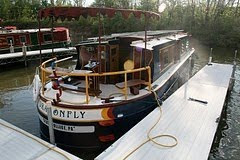

By request, here are photos from the helm, showing the boat's original controls for the diesel engine at right, and the new controls for the electric motor at left.
When you buy a powerboat, one choice you have to make is “single engine or twin engine?” The advantage of twin engines is that, when you’re out on the high seas and one engine dies, you still have a second engine. The disadvantage of twin engines is that they’re more expensive than a single engine--and there’s twice as much engine to break down, which boat engines often do.
Our boat is twin-engine . . . in a way. The original engine is a 60-HP Yanmar diesel. That’s a very common boat engine, so parts are easy to get. And Yanmars have a reputation for lasting a long time.
Bill has ADDED an electric motor to the boat. It’s an AGNI—which is virtually identical to a Lynch electric motor. (If you know your electric motors, you know this is cool: The eccentric Brit Cedric Lynch designed a famous electric motor that has been used to power the world’s fastest electric motorcycle, a novel all-electric plane, and so on. Lynch sold his first company and launched a second one, AGNI. )
Our motor was actually made in India! (Finding it and having it shipped was an adventure Bill will tell you about sometime.) Anyway, now, rather amusingly, a motor that is virtually identical to the one that powers the world’s fastest electric motorcycle is quite effectively powering our slowboat!
How it all works: Our eight solar panels stash power in the bank of batteries Bill added to the boat (there’s half a ton in all, hidden inside the bench seat in front of our desk in the stern cabin). The AGMI electric motor pulls power from this bank of batteries to turn the propshaft. Our diesel motor has its own separate starter battery, not part of this battery bank (and not current powered by solar, but it WILL be! The boat is a work in progress).
Anyway, it IS good to have the flexibility of two motors.
Yesterday (Thursday, June 2), we left Baldwinsville around 9 AM under gray skies and mild temperatures. We had run for 8 hours on stored solar power the previous day, so the battery bank was low—and under cloudy upstate NY skies it wasn’t recharging very fast. So we motored on diesel for while, because we were trying to make a rendezvous with an old friend in Liverpool.
At our diesel cruising speed of 6 mph we actually made it to the rendezvous early, so we cruised up a side loop of the canal and out to Onondaga Lake (near Syracuse, NY). This lake was very polluted when Bill was a boy; today it’s been cleaned up enough that it has been designated an “Important Bird Area” by the National Audubon Society.
Once we passed the jetty and were out on open water Bill cut the motor to save fuel and went belowdecks to work on organizing some gear. When he went to restart the engine and head for port . . . engine dead!
By then, even under clouds, we had enough juice to start the electric engine and motor (very slowly) to safety.







I love the little painting of the village. Who did that?
ReplyDeletehi Cynthia and Bill
ReplyDeleteHi you two
ReplyDeleteWhat and experence you had. Hope all goes better tomorrow. Love you and miss youBUT have a great time.
Mom and Dad
I always say, have good backup! Have another fine day.
ReplyDeleteAunt Mary
Let me just get my math right: 13 tons of steel, 1/2 ton of solar cell batteries, 8 solar panels and twin diesel engines? Holy smokes, I feel all manly and everything just having Bill as a brother and law! ;-) JB
ReplyDeleteSo what's the update on the diesel? What happened?
ReplyDeleteEmily asked about the painting on the door . . . that came with the boat. Stayed tuned for a post with more info about traditional canal boat design
ReplyDeleteDon asked about the diesel. It's a long story involving multiple batteries . . .stay tuned for another post!
Ah, Liverpool! My home town... I remember going to the Onondaga Lake Park and not being able to swim because of the pollution as a kid. We would dig up old pieces of dishware from Syracuse China in the sand instead. I think they used it as fill in the marshy areas to create parts of the park. I remember "fishing" from the jetties!
ReplyDelete